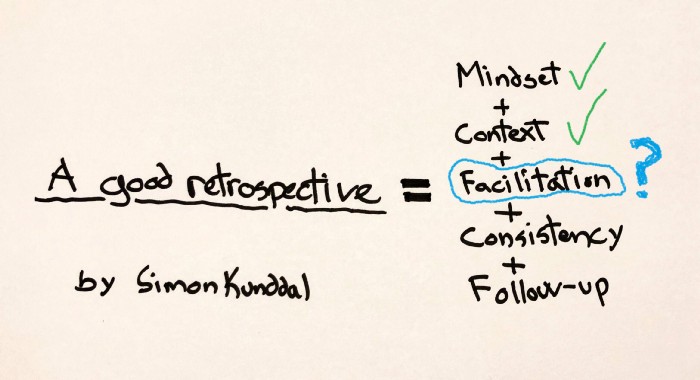
The Retrospective Formula: Facilitation — Part 3

If you have not yet read part 1 and 2 of this article series, I highly recommend checking it out, as this will help the understanding of the coming section.
In part 1 of the Retrospective Formula, I explained the importance of having the right mindset when participating in a retrospective. Part 2 was about understanding the environment and circumstances in which the team operates; to have the right focus at the right time. In this section, I will explore how facilitation is a key principle for a retrospective.
Facilitation Tips & Tricks
It comes as no surprise that facilitation of any agile event is quite important, yet many tend to spend very little time on facilitation once the iterations are rolling. While every agile event requires facilitation there are some unique elements to be aware of in the retrospective.
Safe Space
First of all, you need to create a safe space, or safe room. As explained in part 1 about the mindset, it’s about creating an environment where people can open up to each other. Everybody needs to be comfortable when being in the session. While soft couches can help, this is all about creating a psychological safe space. This could include making sure no manager or HR relations to the team members are present. Personal conflicts should have been solved or paused before the session. A confidentiality agreement signed by all participants agreeing what is said in the room, stays in the room. These are examples on ways to create a safe room. They may seem obvious, but it is sometimes the smaller things that create the optimal conditions for a high level of trust.
Rules
You need to explain the rules for participation. The retrospective will more often than other sessions include sensitive and personal information, and the need for your team members to listen is higher. Examples of rules are: No computers, no phones. Everybody participates actively or leaves the room. You can e.g. use an exercise called ESVP (Explorer, Shopper, Vacationer, Prisoner) exercise from Derby/Larsen to identify what participation level people are at. While explorer, shopper and vacationer are welcome at the session, you will need to ask if the prisoners will either leave, stay silent or change their mindset to be more constructive. In some cases, you may want to provide feedback models, and implement them as rules. This secures a more positive feedback culture.
The fewer the rules the better, but they are needed to a certain degree to help shape the behavior of participants not used to being in a retrospective.
Agenda
I always begin the session by clearly expressing the agenda on a poster, and take the participants through each segment. I explain the purpose of each agenda bullet and the chosen exercise on a high level. I also clearly express if we have a specific theme for the session. This will help align focus for the participants. There will likely be input that is not suited for the chosen focus of the retrospective. Here, I recommend setting up a parking lot, and communicate that you will visit the parking lot near the end of the session. Remember that not every retrospective should be an open brainstorming exercise. Sometimes, it is a better investment deep diving into a known improvement area.
Have more options available
You do not always know what you will find of data and insights. Planning will at the end of the day be based on assumptions until the retrospective actually happens. Sometimes, you arrive at a situation during the retrospective where the original agenda no longer make sense. You may have planned to do a Circle of Questions for generating insights, but if the topic is very concrete, you may want to adapt to a more suitable exercise.
The more experience you get, the larger your backlog of exercises will be. In general, aim for having a response to the outer poles. If the team finds a very concrete topic, find a format where they can start creating the experiment in the retrospective itself. If they select a very diffuse topic like lag of trust in the team etc, you will want to have a more dialogue-based exercise prepared, e.g. the circle of questions.
If you are still new to facilitating, or just in a doubt, a good tip is to reach out to the participants by being very transparent: “We have arrived to this stage at retrospective. The exercise I had planned is not suitable anymore. How do you want proceed?”. This gives the participants the responsibility to make sure we get a good output of this session as well as their buy-in.
Output and Outcome
Clearly express what is the expected output for the current retrospective, and what is the expected outcome after the experiment has been implemented. Many people have high hopes that a single retrospective can solve all of the team’s problems. Often you can only solve a rather small thing each time. It is important that you align expectations on what you want to have ready by the end of the retrospective, and how they can reach the outcome of that output. In most cases, a retrospective should end up with one well defined experiment that is ready to be pulled into the coming sprint backlog. The outcome will come after the experiment has been completed, or the new behavior has been observed. We will discuss following-up in a future part of this series
Facilitation is much more than explained above, but it should help ease the flow and understanding of the process. On average, I recommend that you invest at least twice the amount of time of the retrospective in planning the retrospective and facilitation of it: Ff a retrospective is planned for 2 hours, you will likely need around 4 hours to plan and prepare a good retrospective with relevant exercises.